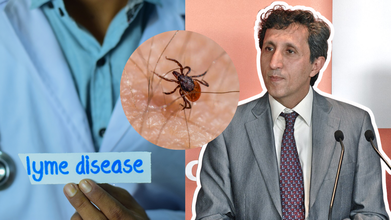- Health Conditions A-Z
- Health & Wellness
- Nutrition
- Fitness
- Health News
- Ayurveda
- Videos
- Medicine A-Z
- Parenting
- Web Stories
Cancer Deaths Among Men Predicted To Surge By 93% By 2050: Key Factors And Overlooked Symptoms

Source: iStock
A recent study has highlighted a troubling trend in cancer mortality rates among men, projecting a significant increase in cancer-related deaths over the coming decades. This alarming projection underscores the urgent need for enhanced prevention, early detection, and treatment strategies to address this growing public health concern.
Published in the journal Cancer, a recent study from Australia analyzed cancer data from 185 countries and territories in 2022 to project future trends. The study forecasts a significant rise in cancer cases and deaths among men by 2050.
Cancer cases among men are expected to grow from 10.3 million in 2022 to 19 million by 2050—an 84% increase. Cancer deaths are projected to rise from 5.4 million to 10.5 million, marking a 93% increase. Specifically, deaths among men aged 65 and older are anticipated to increase by 117%.
Countries with lower income and life expectancy, such as those in Africa and the Eastern Mediterranean, will see a 2.5-fold rise in cancer cases and deaths. Conversely, Europe is projected to experience a 50% increase. The American Cancer Society highlights that the global cancer burden will be significantly impacted by population growth and aging, with the world population expected to reach 9.7 billion by 2050.
Key Factors Contributing to Increased Cancer Deaths
Several factors contribute to the anticipated rise in cancer deaths among men:As the global population ages, the incidence of cancer naturally increases. Older individuals are at higher risk for developing various types of cancer, which contributes significantly to the projected rise in mortality rates.
Lifestyle factors such as smoking, excessive alcohol consumption, poor diet, and physical inactivity play a crucial role in cancer development. Despite ongoing public health efforts, these risk factors remain prevalent, exacerbating the cancer burden.
Many cancers are detected at later stages when treatment options are less effective. Advances in screening and early detection are essential to improve survival rates, but disparities in access to healthcare and screening services persist.
Common Cancer Symptoms Men Often Overlook
- A chronic cough or hoarseness that doesn’t go away may be a sign of lung or throat cancer.- Significant weight loss without a clear reason can indicate various cancers, including those of the stomach, pancreas, or esophagus.
- Persistent pain, especially in the back, abdomen, or pelvis, can be associated with cancers like prostate, colon, or bone cancer.
- Frequent, painful, or difficult urination, or blood in the urine, may signal prostate or bladder cancer.
- Any new lump or swelling, particularly in the testicles, neck, or underarms, could be a sign of cancer, including testicular or lymphatic cancer.
- New or changing moles, sores that don’t heal, or unusual skin changes can be symptoms of skin cancer.
- Persistent nausea, vomiting, difficulty swallowing, or changes in bowel habits might be related to cancers of the digestive system, such as colorectal or stomach cancer.
Importance of Early Detection and Prevention
To combat the anticipated rise in cancer deaths, it is crucial to emphasize preventive measures and early detection. Regular screenings, such as mammograms, colonoscopies, and prostate exams, can help identify cancers in their early stages when treatment is more likely to be successful.Public health initiatives aimed at promoting healthy lifestyles, reducing risk factors, and improving access to healthcare are essential components of a comprehensive strategy to address the rising cancer death rates. Educating individuals about the importance of preventive care and encouraging regular medical check-ups can contribute significantly to reducing cancer mortality.
The projected increase in cancer deaths among men serves as a wake-up call for individuals and healthcare systems alike. Prevention, early detection, and lifestyle changes, it is possible to mitigate the impact of this concerning trend. Ongoing research and public health efforts are crucial to reversing this trajectory and improving outcomes for men facing cancer.
A Mysterious New Fungal Infection Is Spreading In UK Hospitals, Health Expert Warns

Credits: Canva
Health officials across the UK are on alert after identifying a new fungal infection spreading in hospitals. Known as Candidozyma auris (C. auris), this yeast has been named a critical priority pathogen by the World Health Organisation (WHO) because of its growing resistance to treatment and potential danger to vulnerable patients. The UK Health Security Agency (UKHSA) is now working with NHS England and other health partners to monitor rising detections of C. auris, which until recently had been rare in the country. Globally, the infection has been linked to a high death rate, raising concern for hospitalised patients with weakened immune systems.
What Is Candidozyma Auris?
C. auris is a type of fungus that can lead to severe infections, particularly among those who are already ill. Some strains have shown resistance to multiple antifungal drugs, making treatment difficult. It spreads most often in hospitals and long-term care facilities. According to the Cleveland Clinic, infections may include:- Ear infections
- Wound infections
- Urinary tract infections (UTIs)
- Bloodstream infections that can spread throughout the body
Unlike other Candida species, C. auris does not typically live naturally on the body. People usually contract it from contaminated hospital surfaces or from someone who already has the infection. For healthy individuals, the risk of infection remains low.
How Common Are Candidozyma Auris Infections?
C. auris remains uncommon but is considered an emerging infectious disease due to the rising number of reported cases since 2019. Healthcare professionals are increasing infection-control measures to contain its spread in hospitals and care homes.Symptoms Of Candidozyma Auris
The symptoms vary depending on which part of the body is infected. Common signs include:- Fever
- Chills
- Fatigue or extreme tiredness
- Low blood pressure
- Rapid heartbeat (tachycardia)
- Low body temperature (hypothermia)
- Ear pain, pressure, or a sense of fullness (in ear infections)
According to a UKHSA statement, C. auris was first discovered in 2009 in the ear of a patient in Japan and has since been detected in over 40 countries across six continents. The agency explains that the fungus is particularly concerning because it can survive for long periods on surfaces—even in hospital settings—and is often resistant to both standard medical treatments and disinfectants.
Since 2015, several long-lasting outbreaks of C. auris have occurred in UK hospitals, requiring intensive control measures to stop further transmission. Peaks in cases have mostly been linked to these outbreaks.
Can Candidozyma Auris Be Cured?
C. auris infections can often be treated with a type of antifungal medication called echinocandins. However, certain strains are developing resistance, making them more difficult to cure. In such cases, doctors may need to combine different drugs to eliminate the infection. Before starting any medication, it is important to consult a qualified healthcare professional for proper diagnosis and treatment advice.
Delhi’s Artificial Rain Plan To Fight Toxic Smog Fails— Here’s Why It Didn’t Work

Credits: PTI
Artificial Cloud Seeding Delhi: Delhi has long struggled with toxic air. The city often records high pollution levels throughout the year, and in an effort to provide cleaner air to residents, the Delhi government has been exploring cloud seeding or artificial rain for several months.
After more than five decades, Delhi finally carried out cloud seeding trials to trigger artificial rain and bring down rising pollution levels. The project was a joint effort between the Delhi government and the Indian Institute of Technology (IIT) Kanpur, conducted in areas such as Burari, Karol Bagh, Mayur Vihar, and Badli.
However, the experiment failed, as the India Meteorological Department (IMD) did not record any rainfall in the city.
Why Cloud Seeding Failed in Delhi?
According to an NDTV report, IIT Kanpur Director Manindra Agrawal said the attempt was “not completely successful” because the clouds did not have enough moisture. “For rain to form, moisture levels of at least 50 percent are ideal,” he said. “Today’s clouds only had about 15–20 percent moisture, which reduced the chances of rainfall.”
Despite the low humidity, Agrawal said the exercise gave researchers valuable experience and confidence that the method could work under more favorable conditions. While Delhi saw no rainfall, small traces were recorded in Noida (0.1 mm) and Greater Noida (0.2 mm). Two more flights will be carried out once suitable clouds appear.
A report released by the Delhi government on Tuesday evening showed a slight drop in pollution levels in areas where the seeding took place. According to PTI, PM2.5 levels fell marginally in Mayur Vihar, Karol Bagh, and Burari. Environment Minister Manjinder Singh Sirsa called it a “major scientific step” in tackling air pollution and said more trials, possibly up to 10, will be conducted until February if the results remain encouraging.
What Is Cloud Seeding?
Cloud seeding involves adding substances like silver iodide or dry ice to clouds to encourage rainfall or snowfall, reduce hail, or clear fog. It can be carried out using aircraft, rockets, or ground-based equipment.
The formula developed by IIT Kanpur includes silver iodide nanoparticles, iodised salt, and rock salt. These particles act as ice nuclei, helping moisture in the clouds condense and form rain. However, the process depends heavily on having the right level of humidity and moisture in the atmosphere.
Will a Third Round of Cloud Seeding Take Place?
A third round of trials is likely later this week, depending on IMD confirmation of suitable cloud conditions. Similar operations are expected in the coming days. Sirsa told ANI that IIT Kanpur has been collecting large-scale samples during the experiments and will submit a detailed report soon.
Globally, cloud seeding has produced mixed outcomes. China has reported success with using rockets, cannons, and drones to manage rainfall, including before the Olympics. In contrast, the United Arab Emirates faced criticism after last year’s floods in Dubai, raising questions about the method’s safety and reliability.
Dr. Amir Khadir Pleads Guilty Over Controversial Treatments for a Nonexistent Form of Lyme Disease

Credits: Canva and Wikimedia Commons
Dr Amir Khadir, microbiologist and infectious disease specialist at Pierre-Le Gardeur Hospital in Terrebonne, Quebec, Canada pleaded guilty to 12 offences over his controversial treatment of Lyme disease. He had been treating patients with "chronic" Lyme disease since 2019 in his specialized clinic, affiliated to the hospital. However, science does not back that such a condition even exists, confirmed the disciplinary council of the Collège des médecins du Québec (CMQ).
In June 2020, he made a commitment to stop prescribing antibiotics beyond 28 days to treat people with Lyme disease, however, some patients have taken his medications for two years. His long-term antibiotic treatment lasted for more than four months up to two years in his patients.
Also Read: Is The White House Hiding Truth About President Donald Trump’s Health?
What Happened In The Past?
Dr Steven Lapointe, who is a CMQ trustee said that Dr Khadir "admitted four times rather than once that he had not respected his commitment. He spent much more time justifying himself than expressing regret, and even less remorse, for not having respected his commitment. [He made] his own law."
Dr Khadir justified his deed by saying that some of his desperate patients had recovered after prolonged course of antibiotics. He said that there were no complains from his patients about his approach. No complications were reported either.
Dr Khadir had earlier made the government aware of the need to undertake a research and was hoping to seek funding for the same. Le Journal de Montreal reports that he was not to offer antibiotic treatment for Lyme disease for more than 28 days, except as part of a hospital research project. However, as Montreal City News reports, that though he received the approval of the medical and political communities, the fundings had not come, as Quebec allocated the funds for a group of clinics specializing in long COVID and infectious diseases. Thus, he continued to offer antibiotic treatment beyond 28 days outside of a research setting.
"I regret not having done things in the right order. It was a lamentable error of judgment," he said.
Also Read: As U.S. Measles Cases Surge, Could The Country Lose Its Elimination Status?
What Is The Right Way To Treat Lyme Disease?
As per the Centers for Disease Control and Prevention (CDC), most cases of Lyme diseases are treated within 10 to 14 days of antibiotics.
Mayo Clinic notes that the standard treatment for Lyme disease is an antibiotic taken as a pill that lasts 10 to 14 days.
Cleveland Clinic also notes that while antibiotics are the primary treatment for Lyme disease, including doxycycline, amoxicillin, or cefuroxime axetil. The time taken to recover could be around 10 days.
Johns Hopkins Medicine notes that treatment could last up to 21 days.
What Is Lyme Disease?
It is a bacterial infection spread by infected ticks. The initial symptoms can include a 'bull's eye' rash, fever, headache, and fatigue. If it is left untreated, the infection could spread and cause more serious problems affecting joints, heart, and even the nervous system. It is most effectively treated, as many have noted and has been mentioned above, with antibiotics, especially when caught early.
© 2024 Bennett, Coleman & Company Limited

